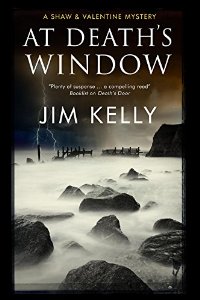Conflicts between criminals tend to be called ‘wars’. Thus we have turf wars, drug wars, and even scraps between rival ice cream vendors which are known as ice cream wars. But here we have a first. In At Death’s Window we bring you samphire wars.
Samphire is an edible plant which grows on coastal marshes, and for centuries was a freely-available cheap food for local people. Now, however, it has been discovered by those who cook and eat the fancy dishes in London’s finest restaurants. Samphire can be picked for nothing or, at worst, bought in Norfolk markets for £2 a kilo, but when it is packed and driven down to London it retails for closer to £20 a kilo. So, in this latest outing for Inspector Peter Shaw and Sergeant George Valentine, trouble breaks out between the local pickers of the plant, and gangs of industrial level harvesters employed by criminals more used to turning a profit by dealing in narcotics.
When a man’s body is found weighted down with a sandbank off the north Norfolk coast, and in his pocket is a bunch of samphire, Shaw is convinced that a message is being sent. But by whom, and to whom? A local wheeler-dealer, John Jack Stepney is the first port of call for the police, but he denies all knowledge. With the Duke and Duchess of Cambridge having announced their plans to live in a local stately home, Shaw is also under pressure to solve a series of break-ins at second homes in the intensely fashionable area of Burnham Market and Brancaster. Then, another body is found. This time, it is that of Shrimp Davies, a local fisherman.
Back at West Norfolk police HQ in the unfashionable town of King’s Lynn, someone is tampering with the drugs sold on the street. They’re being cut with an anti-cancer drug which can cause fatal consequences for the misuser. Shaw has an uneasy feeling that the drug deaths are linked to the samphire wars and the burglaries. And what about the peculiar case of someone shooting out the angels in the stained glass of a King’s Lynn church? How can this be connected to Shaw’s mounting case-load? As Shaw and Valentine strive for a break-through, hindered by their chief constable’s aversion to bad publicity, the list of victims and suspects grows to include a secretive stained glass expert, an ex-policeman who babysits expensive second homes for his London clients, and a disgraced anaesthetist who now lives on the streets and has a fear of angels.
There is so much to enjoy about this book. Unusually, both Shaw and Valentine are equally fully rounded and imagined characters, unlike many fictional inspector-sergeant duos. Valentine’s slightly dour and introspective outward demeanour plays beautifully alongside his constant grief over the death of his wife. Shaw is a good copper, but he is constantly worried about his eyesight problems, and the business plans of his wife, Lena.
Kelly has a painter’s eye for landscape, and the imagination of a poet. His prose is effortless and elegant without being in the least bit pretentious. At Death’s Window is much more than a police procedural, even though it operates on one level as a classic whodunnit. The final plot twists are ingenious but totally plausible, and there are many real-life issues raised in the book, which make it all the more thoughtful – and thought-provoking. Finally, and more trivially, anyone who knows King’s Lynn well will have great fun spotting the local landmarks which Kelly uses as a backdrop.
Creme de la Crime
Print
£19.99
CFL Rating: 5 Stars









